
- Machine Learning Basics
- Machine Learning - Home
- Machine Learning - Getting Started
- Machine Learning - Basic Concepts
- Machine Learning - Python Libraries
- Machine Learning - Applications
- Machine Learning - Life Cycle
- Machine Learning - Required Skills
- Machine Learning - Implementation
- Machine Learning - Challenges & Common Issues
- Machine Learning - Limitations
- Machine Learning - Reallife Examples
- Machine Learning - Data Structure
- Machine Learning - Mathematics
- Machine Learning - Artificial Intelligence
- Machine Learning - Neural Networks
- Machine Learning - Deep Learning
- Machine Learning - Getting Datasets
- Machine Learning - Categorical Data
- Machine Learning - Data Loading
- Machine Learning - Data Understanding
- Machine Learning - Data Preparation
- Machine Learning - Models
- Machine Learning - Supervised
- Machine Learning - Unsupervised
- Machine Learning - Semi-supervised
- Machine Learning - Reinforcement
- Machine Learning - Supervised vs. Unsupervised
- Machine Learning Data Visualization
- Machine Learning - Data Visualization
- Machine Learning - Histograms
- Machine Learning - Density Plots
- Machine Learning - Box and Whisker Plots
- Machine Learning - Correlation Matrix Plots
- Machine Learning - Scatter Matrix Plots
- Statistics for Machine Learning
- Machine Learning - Statistics
- Machine Learning - Mean, Median, Mode
- Machine Learning - Standard Deviation
- Machine Learning - Percentiles
- Machine Learning - Data Distribution
- Machine Learning - Skewness and Kurtosis
- Machine Learning - Bias and Variance
- Machine Learning - Hypothesis
- Regression Analysis In ML
- Machine Learning - Regression Analysis
- Machine Learning - Linear Regression
- Machine Learning - Simple Linear Regression
- Machine Learning - Multiple Linear Regression
- Machine Learning - Polynomial Regression
- Classification Algorithms In ML
- Machine Learning - Classification Algorithms
- Machine Learning - Logistic Regression
- Machine Learning - K-Nearest Neighbors (KNN)
- Machine Learning - Naïve Bayes Algorithm
- Machine Learning - Decision Tree Algorithm
- Machine Learning - Support Vector Machine
- Machine Learning - Random Forest
- Machine Learning - Confusion Matrix
- Machine Learning - Stochastic Gradient Descent
- Clustering Algorithms In ML
- Machine Learning - Clustering Algorithms
- Machine Learning - Centroid-Based Clustering
- Machine Learning - K-Means Clustering
- Machine Learning - K-Medoids Clustering
- Machine Learning - Mean-Shift Clustering
- Machine Learning - Hierarchical Clustering
- Machine Learning - Density-Based Clustering
- Machine Learning - DBSCAN Clustering
- Machine Learning - OPTICS Clustering
- Machine Learning - HDBSCAN Clustering
- Machine Learning - BIRCH Clustering
- Machine Learning - Affinity Propagation
- Machine Learning - Distribution-Based Clustering
- Machine Learning - Agglomerative Clustering
- Dimensionality Reduction In ML
- Machine Learning - Dimensionality Reduction
- Machine Learning - Feature Selection
- Machine Learning - Feature Extraction
- Machine Learning - Backward Elimination
- Machine Learning - Forward Feature Construction
- Machine Learning - High Correlation Filter
- Machine Learning - Low Variance Filter
- Machine Learning - Missing Values Ratio
- Machine Learning - Principal Component Analysis
- Machine Learning Miscellaneous
- Machine Learning - Performance Metrics
- Machine Learning - Automatic Workflows
- Machine Learning - Boost Model Performance
- Machine Learning - Gradient Boosting
- Machine Learning - Bootstrap Aggregation (Bagging)
- Machine Learning - Cross Validation
- Machine Learning - AUC-ROC Curve
- Machine Learning - Grid Search
- Machine Learning - Data Scaling
- Machine Learning - Train and Test
- Machine Learning - Association Rules
- Machine Learning - Apriori Algorithm
- Machine Learning - Gaussian Discriminant Analysis
- Machine Learning - Cost Function
- Machine Learning - Bayes Theorem
- Machine Learning - Precision and Recall
- Machine Learning - Adversarial
- Machine Learning - Stacking
- Machine Learning - Epoch
- Machine Learning - Perceptron
- Machine Learning - Regularization
- Machine Learning - Overfitting
- Machine Learning - P-value
- Machine Learning - Entropy
- Machine Learning - MLOps
- Machine Learning - Data Leakage
- Machine Learning - Resources
- Machine Learning - Quick Guide
- Machine Learning - Useful Resources
- Machine Learning - Discussion

Machine Learning Tutorial
Machine Learning, often abbreviated as ML is a branch of Artificial Intelligence (AI) that works on algorithm developments and statistical models that allow computers to learn from data and make predictions or decisions without being explicitly programmed. Hence, in simpler terms, machine learning allows computers to learn from data and make decisions or predictions without being explicitly programmed to do so. Essentially, machine learning algorithms learn patterns and relationships from data, allowing them to generalize from instances and make predictions or conclusions on new and uncovered data.
How does Machine Learning Work?
Broadly Machine Learning process includes Project Setup, Data Preparation, Modeling and Deployment. The following figure demonstrates the common working process of Machine Learning. It follows some set of steps to do the task; a sequential process of its workflow is as follows -
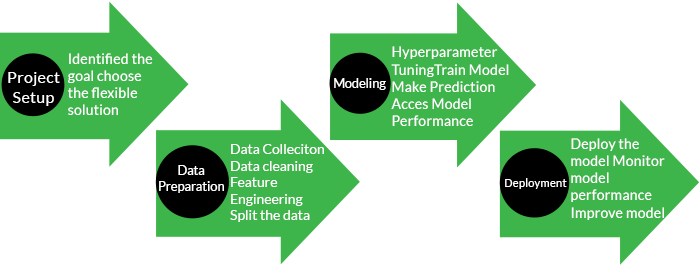
Stages of Machine Learning
A detailed sequential process of Machine Learning includes some set of steps of phases which are as –
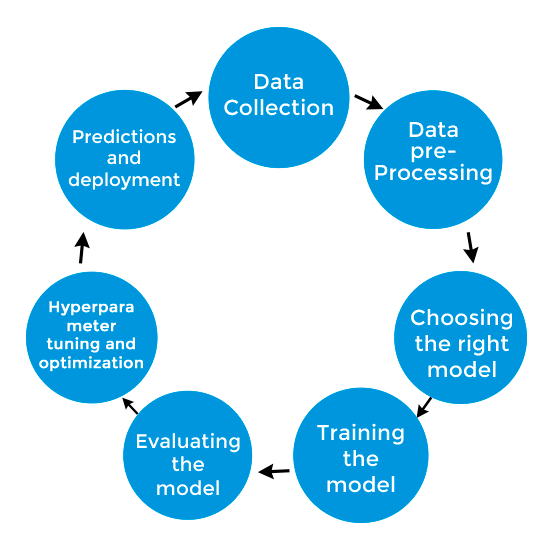
- Data collection: Data collection is an initial step in the process of machine learning. Data is a fundamental part of machine learning, the quality and quantity of your data can have direct consequences for model performance. Different sources such as databases, text files, pictures, sound files, or web scraping may be used for data collection. Data needs to be prepared for machine learning once it has been collected. This process is to organize the data in an appropriate format, such as a CSV file or database, and make sure that they are useful for solving your problem.
- Data pre-processing: Pre-processing of data is a key step in the process of machine learning. It involves deleting duplicate data, fixing errors, managing missing data either by eliminating or filling it in, and adjusting and formatting the data. Pre-processing improves the quality of your data and ensures that your machine-learning model can read it right. The accuracy of your model may be significantly improved by this step.
- Choosing the right model: The next step is to select a machine learning model; once data is prepared then we apply it to ML Models like Linear regression, decision trees, and Neural Networks that may be selected to implement. The selection of the model generally depends on what kind of data you're dealing with and your problem. The size and type of data, complexity, and computational resources should be taken into account when choosing a model to apply.
- Training the model: The next step is to train it with the data that has been prepared after you have chosen a model. Training is about connecting the data to the model and enabling it to adjust its parameters to predict output more accurately. Overfitting and underfitting must be avoided during the training.
- Evaluating the model: It is important to assess the model's performance before deployment as soon as a model has been trained. This means that the model has to be tested on new data that they haven't been able to see during training. Accuracy in classifying problems, precision and recall for binary classification problems, as well as mean error squared with regression problems, are common metrics to evaluate the performance of a model.
- Hyperparameter tuning and optimization: You may need to adjust its hyperparameters to make it more efficient after you've evaluated the model. Grid searches, where you try different combinations of parameters, and cross-validation, where you divide your data into subsets and train your model on each subset, to ensure that it performs well on different data sets, are techniques for hyperparameter tuning.
- Predictions and deployment: As soon as the model has been programmed and optimized, it will be ready to estimate new data. This is done by adding new data to the model and using its output for decision-making or other analysis. The deployment of this model involves its integration into a production environment where it is capable of processing real-world data and providing timely information.
Types of Machine Learning
Machine learning models fall into the following categories:
-
Supervised Machine Learning (SVM): Supervised machine learning uses labeled datasets to train algorithms to classify data or predict outcomes. As input data is inputted into the model, its weights modify until it fits into the model; this process is known as cross validation which ensures the model is not overfitted or underfitted.
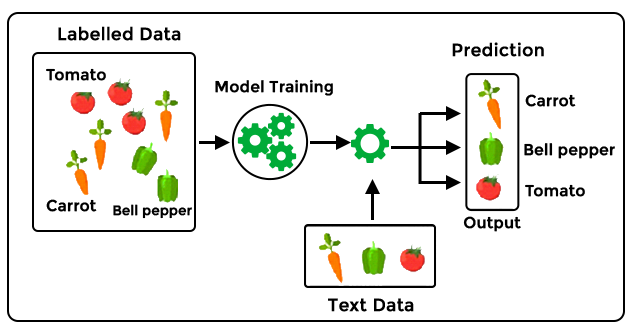
Supervised learning helps organizations scale real-world challenges like spam classification in a different folder from your inbox. Different methods for supervised learning include neural networks, naïve Bayes, linear regression, logistic regression, random forest, and SVM. -
Unsupervised Machine Learning: Unsupervised machine learning analyses and clusters unlabelled datasets using machine learning methods. The algorithms find hidden patterns or data groupings without human interaction. This method is useful for exploratory data analysis, cross-selling, consumer segmentation, and image and pattern recognition.
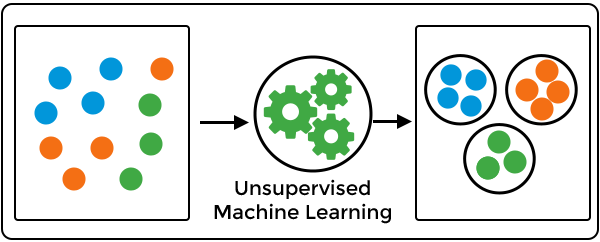
It also reduces model features through dimensionality reduction using prominent methods of Principal component analysis (PCA) and singular value decomposition (SVD). Neural networks, k-means clustering, and probabilistic clustering are some popular methods of unsupervised learning. -
Semi-supervised learning: As its name implies; Semi-supervised learning is an integration of supervised and unsupervised learning. This method uses both labeled and unlabelled data to train ML models for classification and regression tasks. Semi-supervised learning is a best practice to utilize to solve the problem where a user doesn't have enough labeled data for a supervised learning algorithm.
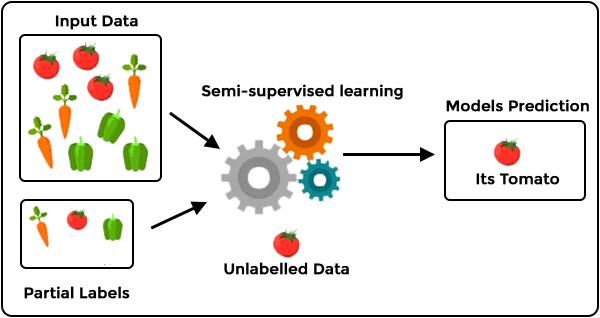
Hence, it's an appropriate method to solve the problem where data is partially labeled or unlabelled. Self-training, co-training, and graph-based labeling are some of the popular Semi-supervised learning methods. -
Reinforcement Machine Learning: Reinforcement machine learning is a type of machine learning model that is similar to supervised learning but does not use sample data to train the algorithm. This model learns by trial and error.

A series of good results will be reinforced to create the optimal proposal or policy for a specific problem.
Common Machine Learning Algorithms
Several machine learning algorithms are commonly used. These include:
- Neural networks: Neural networks function similarly to the human brain, comprising multiple linked processing nodes. Neural networks excel at pattern identification and are used in different applications such as natural language processing, image recognition, speech recognition, and creating images.
- Linear regression: This algorithm predicts numerical values using a linear relationship between variables. For example, linear regression is used to forecast housing prices based on past data in a particular area.
- Logistic regression: This supervised learning method predicts categorical variables, such as "yes/no" replies to questions. It is suitable for applications such as spam classification and quality control on a production line.
- Clustering: Clustering algorithms use unsupervised learning to find patterns in data and organise it accordingly. Computers can assist data scientists by identifying differences between data items that humans have overlooked.
- Decision trees: Decision trees are useful for categorising data and for regression analysis, which predicts numerical values. A tree structure can be used to illustrate the branching sequence of linked decisions used in decision trees. Unlike neural networks, decision trees can be easily validated and audited.
- Random forests: ML predicts a value or category by integrating results from different decision trees.
Importance of Machine Learning
Machine Learning is important in automation, extracting insights from data, and decision-making processes. It has its significance due to the following reasons:
- Data processing: The main reason machine learning has become so important is to process and make sense of large amounts of data. Traditional methods of data analysis are becoming insufficient given the explosion of digital information coming from social media, sensors, and other sources. This data is important and reveals hidden patterns and provides invaluable insight for decision-making processes, which can be exploited by machine learning algorithms.
- Data-driven insights: Machine learning algorithms can find patterns, trends, and correlations in big data sets that humans cannot. Better decisions and forecasts can be made with this information.
- Automation: Machine learning automates manual activities, saving time and decreasing errors by learning from data and improving over time, ML algorithms can perform previously manual tasks, freeing humans to focus on more complex and creative tasks. This not only increases efficiency but also opens up new possibilities for innovation. Data entry, classification, and anomaly detection can be automated with machine learning.
- Personalization: User preferences and behavior can be analyzed using machine learning algorithms to generate personalized recommendations and experiences. It is most widely used in social media like e-commerce, and streaming services by providing a way to increase user engagement and satisfaction.
- Predictive analytics: Models of machine learning may be trained to predict subsequent outcomes based on past data. This is useful for different applications like sales forecasts, risk management, and demand planning.
- Optimization: Machine learning algorithms optimize systems and processes for efficiency and performance. Their smart grid optimizations include supply chain logistics, resource allocation, and energy consumption.
- Pattern recognition: Machine learning is useful in image, audio, and natural language processing because it can recognize complicated data patterns easily and timely.
- Healthcare: Machine learning is used in disease diagnosis, outbreaks; personalized patient treatment plans, personalized treatment planning, medical imaging accuracy, and drug discovery. It accurate diagnosis, medical image processing, genomic data, and electronic health records.
- Finance: Machine learning is used for credit scoring, algorithmic trading, and fraud detection.
- Retail: Machine learning can also be used for recommendation systems, supply chains, or customer service.
- Fraud detection and cybersecurity: Machine Learning algorithms can detect patterns of fraudulent behavior for financial transactions by detecting and mitigating security threats in real-time, it is used to enhance cybersecurity as well.
- Continuous improvement: It is possible to train and update machine learning models with new data at regular intervals, enabling them to adapt to changes in the environment as well as improve over time.
Machine Learning enables organizations to take advantage of the power of data to gain insight, streamline processes and drive innovation throughout a variety of sectors.
Applications of Machine Learning
Nowadays; Machine Learning is used almost everywhere. However, some most commonly used applicable areas of Machine Learning are:
- Speech recognition: It is also known as automatic speech recognition (ASR), computer speech recognition, or speech-to-text, and it is a capability that uses natural language processing (NLP) to translate human speech into a written format. To perform voice search, such as Siri, or improve text accessibility, a large number of Mobile Devices incorporate speech recognition into their systems.
- Customer service: Chatbots are replacing human operators on websites and social media, affecting client engagement. Chatbots answer shipping FAQs, offer personalized advice, cross-sell products, and recommend sizes. Some common examples are virtual agents on e-commerce sites, Slack and Facebook Messenger bots, and virtual and voice assistants.
- Computer vision: This artificial intelligence technology allows computers to derive meaningful information from digital images, videos, and other visual inputs that can then be used for appropriate action. Computer vision, powered by convolutional neural networks, is used for photo tagging on social media, radiology imaging in healthcare, and self-driving cars in the automotive industry.
- Recommendation engines: AI algorithms may help to detect trends in data that might be useful for developing more efficient marketing strategies using past data patterns. Online retailers use recommendation engines to provide their customers with relevant product recommendations for the purchasing process.
- Robotic process automation (RPA): Also known as software robotics, RPA uses intelligent automation technologies to perform repetitive manual tasks.
- Automated stock trading: AI-driven high-frequency trading platforms are designed to optimize stock portfolios and make thousands or even millions of trades each day without human intervention.
- Fraud detection: Machine learning is capable of detecting suspected transactions for banks and others in the financial sector. A model can be trained by supervised learning, based on knowledge of recent fraudulent transactions. Anomaly detection may identify transactions that appear unusual, and need to be followed up.
Target Audience
This machine learning tutorial has been prepared for those who want to learn about the basics and advances of Machine Learning. In a broader sense; ML is a subset of Artificial Intelligence (AI) that focuses on developing algorithms and models that allow computers to learn from data and make predictions or decisions without being explicitly programmed to do so. Machine learning requires data. This data can be text, images, audio, numbers, or video. The quality and quantity of data considerably affect machine learning model performance. Features are data qualities used to predict or decide. Feature selection and engineering entail selecting and formatting the most relevant features for the model.
Prerequisites to Learn Machine Learning
You should have a basic understanding of the technical aspects of Machine Learning. Learners should be familiar with data, information, and its basics. Knowledge of Data, information, structured data, unstructured data, semi-structured data, data processing, and Artificial Intelligence basics; Proficiency in labeled / unlabelled data, feature extraction from data, and their application in ML to solve common problems is a must.
Algorithms and mathematical models are the most essential things to learn before exploring Machine Learning concepts. These prerequisites give a solid basis for Machine Learning, but it's also important to understand that the specific requirements may vary as per Machine Learning models, complexity, cutting-edge technologies, and nature of the work.